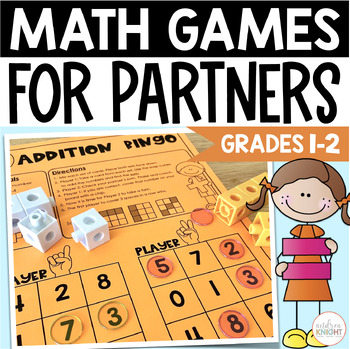Math Games for 1st and 2nd Grade - Low Prep Games for Partners or Math Centers
- PDF
What educators are saying
Also included in
- MATH BUNDLE for 1st GRADE STUDENTSThis First Grade Math Bundle includes 12 standards-based resources developed for children in 1st grade to help them review and master math skills in fun and engaging ways. The bundle includes resources covering multiple first grade concepts, such as:basic addition aPrice $48.00Original Price $67.95Save $19.95
Description
MATH GAMES / MATH CENTERS for FIRST and SECOND GRADE
I love these low-prep MATH GAMES for PARTNERS. They're quick and easy to put together and the children enjoy playing them over and over. You can use them in multiple ways, but I most often use them:
- during math workshop
- as independent math centers
- for a fun home activity with a family member
They are perfect for 1st graders and for 2nd graders who need reteaching or review. Each game requires a few materials, but most are common in primary classrooms, especially if you have a commercially published math series.
For example, you will need items such as:
- two-sided colored chips
- counters
- dice
- snap cubes
- tens frames
- base ten blocks
- playing cards
There are 26 PARTNER GAMES in the set:
- Addition Bingo
- One More, Please
- High to Low Tic-Tac-Toe
- Beat Ten
- Roll and Subtract
- Take Away One
- Sums of Ten
- Make a Ten to Win
- What's Missing
- Trio Trouble
- Top This!
- Place Value Connect Three
- Even Steven
- Tally Ho!
- Doubles, Doubles
- Doubles Plus One
- Match and Cover
- Fact Family Fun
- Nickel and Penny Money Jars
- AND MORE!
The games provide practice for many MATH SKILLS including:
- addition and subtraction
- sequencing numbers
- missing addends
- greater than / less than
- place value (tens and ones)
- odd and even numbers
- tally marks
- doubles facts
- sums of ten
- counting coins (pennies, nickels, and dimes)
All copies are blackline pages. Print and laminate for durability.
Click on VIEW PREVIEW above to see sample pages.
HELP PREVENT SUMMER REGRESSION:
TEACHERS LIKE YOU SAID:
⭐️⭐️⭐️⭐️⭐️ “I love how easy to prep and explain these games are! They are so engaging and offer variety without hours and hours of prep." (The Wright Teaching)
⭐️⭐️⭐️⭐️⭐️ “Yes! Yes! Yes! These saved me during unit one of math this year. My kids lack stamina and I need to meet with my low math students. This was just the thing that let me meet my kids who needed intervention and keep my other students working on skills. Their number fluency is improving because of these games!" (Meredith M.)
⭐️⭐️⭐️⭐️⭐️ “I used these in class for partner games to reinforce our math skills. I also sent them home for fun practice! Excellent resource!" (Lynn W.)
ADDITIONAL MATH RESOURCES:
- Let's Practice Place Value
- Missing Addends (Written Equations and Word Problems)
- 2-Digit Addition
- Word Problems for First Grade - Addition and Subtraction
- Data Daze: Collecting, Graphing, and Analyzing Data
Thank you for your interest in this item.
After purchasing, REMEMBER TO LEAVE FEEDBACK.
Each review leads to TPT CREDIT you can use for future purchases!
Copyright © Andrea Knight
All rights reserved by the author.
Permission to copy for single classroom use only.






